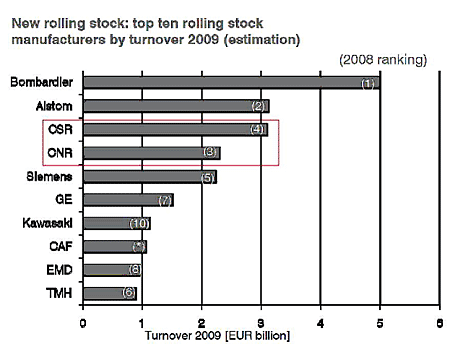
To the average British rail commuter, the notion of sleek, efficient, high speed trains seems laughable. Just finding a train that can get you from point A to point B at somewhere near the promised time is an achievement. Doing it without bankrupting yourself is another thing altogether.
High-speed rail links are a dream that’s been promised to the British commuter by various governments for years. Yet it never seems to come true.
But the outlook for commuters elsewhere in the world is far more promising. While you were slogging your way in and out of work yesterday, China was unveiling the fastest train line in the world.
And this isn’t some bold but ultimately doomed ‘prestige’ project like Concorde. It’s merely the latest addition to an already extensive network of high-speed rail links.
Indeed, I reckon high speed rail could be one of the most important investment themes of the next few years. Here’s why.
The world’s fastest train runs between Shanghai Pudong International Airport and the city outskirts. As it glides along the track, LED screens in the carriages show the speed tick up to as much as 431km an hour (that’s 268 miles per hour). A return journey costs £7.50. That’s less than the price of a peak-time London Underground ticket.
By contrast, one of Britain’s high-speed trains, the Virgin Pendolino, travels from Birmingham to London at about 200km an hour (or 125 miles an hour).
When it comes to high speed rail, China is thinking big. By 2020, all major cities in China will be connected by trains that run at 350km an hour. Beijing is investing $300 billion upfront. The World Bank described the project as “the biggest single planned program of passenger-rail investment there has ever been in one country”.
The rest of the world is now playing catch up. Billions of dollars are being poured into high speed rail – and just a handful of companies are equipped to scoop it up.
How China took the lead in high speed rail
The Shanghai train is a ‘Maglev’, short for ‘magnetic levitation’. It actually floats just above the track. Magnets propel it forward silently and the lack of friction allows it to reach phenomenal speeds.
Ironically, the world’s first commercial Maglev ran from Birmingham International to Birmingham airport back in 1984. But the UK let the technology slip through its fingers. The route was dismantled in 1995 and replaced by a bus.
Special FREE report from MoneyWeek magazine: Don’t be fooled – house prices will fall again!
- Why UK property prices are set to collapse by 30%
- When it will be time to get back in and buy up dirt cheap property
Meanwhile, Beijing has eagerly sucked up all the cutting-edge rail technology it can find. When it announced its plans back in 2004, the companies that came forward to bid for the biggest rail contracts in history were a who’s who of rail technology: Bombardier (Canada), Siemens (Germany), Alstom (France) and Kawasaki Heavy Industries (Japan).
In the competition for contracts, the companies agreed to onerous terms and conditions. Production had to occur in China, and they had to agree to ‘technology transfers’, effectively helping to set up their own cheap Chinese competitors. Beijing has a word for this acquisitive process: ‘digesting’.
Six years later, high speed rail companies are now having to compete with the Chinese rivals they created. Two Chinese manufacturers, CSR and CNR, are already among the world’s top four train makers, as the chart below shows.
These companies are now snapping at each other’s heels to land contracts world wide. We’re about to see the biggest expansion of rail since the days of the Wild West. Billions of dollars are being pumped into high-speed rail projects worldwide, from Bologna, to Argentina, to California. It could be one of the most lucrative investment themes of the decade.
Why are governments so taken with high speed rail?
First off, there’s the ‘green’ vote – ‘greenhouse gas’ emissions can be up to 90% lower than flying. It makes economic sense too – better transport links mean a more mobile, productive workforce, which makes life cheaper for companies. And rail schemes are also big employers. The Beijing-Shanghai link alone employs 110,000 workers.
In the US, $8bn of stimulus funds has been set aside for high speed rail projects. A $2.7bn project in Florida is set to open in 2015, and a Los Angeles-to-San Francisco link costing upwards of $40bn should open in 2020. And on Tuesday 28 September, Amtrak unveiled a $117bn, 30-year vision for a high speed rail line linking the entire East Coast.
Political grandstanding by the Republicans may cause problems for some of these projects. But the US is just one of many countries looking at high-speed rail. Here in Britain, construction on a line linking London to the cities of Birmingham, Manchester and Leeds is due to start in 2015. And projects are also underway in Spain, Italy, South Korea and India.
So how can you get in on the action?
In terms of rolling stock, the major international high speed rail manufacturers should all continue to do very nicely. Companies to investigate further in the sector include Bombardier, Kawasaki Heavy Industries, Siemens and KTX-Sancheon.
As for signalling, the UK’s Invensys is up there with the best, as is France’s Thales. Meanwhile other large Chinese rail businesses are China High Speed Transmission Equipment Group, China Railway Construction and China Railway Group.
Editor’s note: Paul will be keeping a close eye on this sector, along with other major investment themes, in his newsletter, Precision Guided Investments.
Our recommended article for today
Where to take shelter from quantitative easing
Western governments are about to set out on another bout of money-printing. So what can you do to protect your wealth? Bengt Saelensminde looks at one sector that could provide you with a safe harbour.